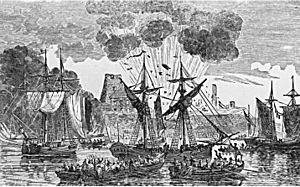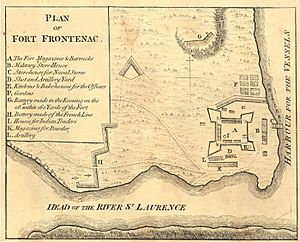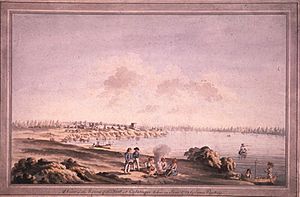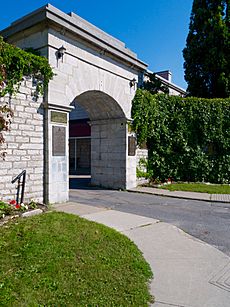Fort Frontenac facts for kids
Quick facts for kids Fort Frontenac (formerly Fort Cataraqui) |
|
|---|---|
| Part of chain of French forts throughout Great Lakes and upper Mississippi region. | |
| Mouth of Cataraqui River, Kingston, Ontario, Canada | |
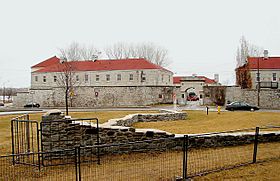
Remnants of the old fort with the new Fort Frontenac in background
|
|
| Site information | |
| Controlled by | Original: New France |
| Condition | Present fort: military barrack buildings used as college. Remnants of original stone fort can be seen. |
| Site history | |
| Built | 1673 |
| Built by | Louis de Buade de Frontenac |
| In use | 1673– present. Periods of abandonment. |
| Materials | Original: wood palisade, partially rebuilt with stone in 1675, rebuilt completely of stone 1695. |
| Demolished | 1689 but later rebuilt. Destroyed by British, 1758. Partly rebuilt, 1783. |
| Battles/wars | Iroquois siege, 1688, Battle of Fort Frontenac (Seven Years' War), 1758 |
| Garrison information | |
| Occupants | French, British, Canadian |
| Designated: | 1923 |
Fort Frontenac was an important French trading post and military fort. It was built in July 1673 at the mouth of the Cataraqui River, where the St. Lawrence River flows out of Lake Ontario. This area is now Kingston, Ontario, Canada.
The first fort was a simple wooden fence structure called Fort Cataraqui. It was later named after Louis de Buade de Frontenac, who was the Governor of New France and helped build the fort. The fort was left empty and destroyed in 1689, but it was rebuilt in 1695.
The British destroyed the fort in 1758 during the Seven Years' War. Its ruins were left abandoned until the British took control and rebuilt it in 1783. In 1870–71, the fort was given to the Canadian military, who still use it today.
Contents
History of Fort Frontenac
Building the Fort and Its Early Days
Fort Frontenac was built to control the valuable fur trade in the Great Lakes Basin and the northern Canadian Shield. It was one of many French outposts built across the Great Lakes and upper Mississippi regions. The fort also acted as a defense against the English, who were also trying to control the fur trade.
By building this trading post, the French hoped to encourage trade with the Iroquois people. The Iroquois were often allied with the English and could be a threat to the French. The fort also supplied other French forts on the Great Lakes and in the Ohio Valley.
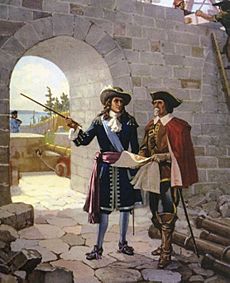
Explorer René Robert Cavalier de La Salle was told by Governor Daniel de Rémy de Courcelle to choose a spot for a fort. He picked the important meeting point of Lake Ontario, the Cataraqui River, and the St. Lawrence River. Governor Louis de Buade de Frontenac, who took over from de Courcelle, was worried about Iroquois threats. He supported La Salle's idea.
Governor Frontenac and his friends also hoped to gain money from building the fort by controlling trade. On July 12, 1673, Governor Frontenac traveled up the St. Lawrence River to the future fort site. There, he met with leaders of the Five Nations of the Iroquois. He encouraged them to trade with the French and began building the fort. The fort was made of wood and surrounded by a wooden stockade (sharpened poles). It was finished in just six days.
La Salle managed the fort. He built storage buildings and homes, brought in farm animals, and grew crops outside the fort. This was done to attract more settlers to the area.
The fort was placed to protect a small, calm bay. The French could use this bay as a harbor for large boats that could travel on the lakes. Unlike the Ottawa River fur trade route, which only canoes could use, larger ships could easily sail on the lower Great Lakes. This made it cheaper to move goods like furs, trade items, and supplies through the lower Great Lakes.
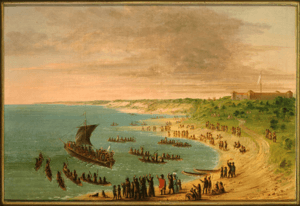
La Salle was given special land rights, called seigneurial privileges, near the fort. In return, he had to pay Frontenac back for building costs. He also had to keep 20 workers at the site for two years and maintain the fort. In 1675, La Salle rebuilt the fort. He added strong stone bastions (parts of a fort wall that stick out) and a stone wall. Much of the wooden fence was also rebuilt.
La Salle also had to attract settlers and provide for their religious needs. He built a chapel and started a mission with one or two Recollet priests. A description from the 1600s said that:
Three quarters of it are of masonry or hardstone, the wall is three feet thick and twelve high. There is one place where it is only four feet, not being completed. The remainder is closed in with stakes. There is inside a house of squared logs, a hundred feet long. There is also a blacksmith's shop a guardhouse, a house for the officers, a well, and a cow-house. The ditches are fifteen feet wide. There is a good amount of land cleared and sown around about, in which a hundred paces away or almost there is a barn for storing the harvest. There are quite near the fort several French houses, an Iroquois village, a convent and a Recollet church.
La Salle used Fort Frontenac as a convenient starting point for his explorations into the middle of North America.
Iroquois Siege and Rebuilding
Rivalries over the fur trade caused problems between the French and the Iroquois in the 1680s. The French began a military campaign against the Iroquois. This started with Governor Antoine Lefèbvre de La Barre's failed trip to Fort Frontenac and into Seneca territory south of Lake Ontario in 1684.
In 1687, La Barre's replacement, the Marquis de Denonville, gathered an army to travel into Seneca territory. To hide his true plans, Denonville pretended he was just going to a peace meeting at Fort Frontenac. As Denonville and his army moved up the St. Lawrence towards the fort, several Iroquois people were captured and imprisoned at Fort Frontenac. These included women, children, and some important leaders. This was done to stop them from telling the Seneca where Denonville's troops were. Some were held as hostages and sent to Montreal. Some were even sent to France to be used as galley slaves (people forced to row large ships). Denonville's troops and their native allies then attacked the Seneca.
In response, the Iroquois attacked Fort Frontenac and blocked Lake Ontario. The fort and the settlement at Cataraqui were under siege (surrounded and attacked) for two months in 1688. The fort itself was not destroyed, but the settlement was ruined, and many people died, mostly from scurvy (a disease caused by lack of Vitamin C).
The French abandoned and destroyed the fort in 1689. They said it was too far away to defend properly and couldn't be supplied well. The French took control of the fort again in 1695. It was rebuilt and made stronger to be used mainly as a military base. From Fort Frontenac in 1696, the French planned an attack on the Iroquois living south of Lake Ontario.
More tension between the British and French in the 1740s led the French to improve the fort's defenses. They added new guns, built new barracks (military housing), and increased the number of soldiers. However, when the Marquis de Montcalm arrived at the fort in 1756 to attack the British at Fort Oswego, he was not impressed with how it was built. One of his engineers wrote that:
The fort has a simple revetement of masonry, with poor foundations of small stones badly set, and the lime is bad; one could easily damage it with a sledge or a pick. The wall is about three to three and a half feet thick at the bottom and two at the top; it has been necessary to build walls for cover. The walls are from 20 to 25 feet high; there are no moats. The trees have been cut down within cannon-shot north and west and about two cannon-shots from the west to the south. ...As for the interior, a wooden scaffold has been built all around except along the north curtain where the commandant's house and chapel are, where the buildings are against the wall. This scaffold is too high; battlements have been let in on a level with the scaffold only eight inches high, which makes them useless. There are two openings for cannons on certain faces of the basions and one on the flanks. There are some places where the scaffold and even the wall would not stand cannon-fire long.
The fort's importance slowly decreased. Other forts like Fort Niagara, Fort Detroit, and Fort Michilimackinac became more important. By the 1750s, Fort Frontenac was mainly used as a storage place for supplies and a harbor for French naval ships. Its group of soldiers had also become very small.
The Battle of Fort Frontenac
During the Seven Years' War (a big war between Britain and France for control of North America), the British saw Fort Frontenac as a threat. It controlled the routes for transport and communication to other French forts along the St. Lawrence – Great Lakes water route and in the Ohio Valley. Even though it wasn't as important as it once was, the fort still supplied the western outposts. The British believed that if they could disable the fort, supplies would be cut off, and the outposts would not be able to defend themselves. The trade with Native Americans in the upper country would also be stopped.
Fort Frontenac was also seen as a threat to Fort Oswego. The British built Fort Oswego across the lake from Fort Frontenac in 1722 to compete for trade with Native Americans. Later, it became a military base. General Montcalm had already used Fort Frontenac as a starting point to attack the forts at Oswego in August 1756.
The British also hoped that capturing the well-known fort would make their soldiers feel better and bring honor after their sad defeat at Fort Ticonderoga (Fort Carillon) in July 1758.
In August 1758, the British, led by Lieutenant-Colonel John Bradstreet, left Fort Oswego with over 3000 men. They attacked Fort Frontenac. The fort's small group of 110 defenders, including soldiers, employees, women, children, and 8 Native Americans, surrendered. They were allowed to leave. Bradstreet captured the fort's supplies and nine French naval ships. He destroyed much of the fort. He quickly left to avoid more fighting with any French support troops.
For the British, Fort Oswego was now safe, and their army's reputation was improved. For the French, losing the fort was seen as only a temporary problem. Fort Frontenac's surrender did not completely cut off French communication and transport to the west. Other routes were available, like the Ottawa River – Lake Huron route. Supplies could also be moved west from other French posts. However, in the long run, the surrender made the French look weaker to the Native Americans and helped lead to France's defeat in North America. Since the fort was no longer important to the French, it was never rebuilt and was left empty for the next 25 years.
French power was fading in the late 1750s. By 1763, France had left the North American mainland. Cataraqui and the remains of Fort Frontenac were given to the British.
Rebuilding and Modern Times
In 1783, the British chose the Cataraqui region as a place to settle United Empire Loyalists. These were people who had left the United States after the American War of Independence. The main part of this region, a community around the old fort, would later become the city of Kingston.
General Sir Frederick Haldimand, who was the Governor of the Province of Quebec, told Major John Ross to fix and rebuild the fort for a military group. This was done by 422 men and 25 officers. By October 1783, a lime kiln, hospital, barracks, officers' quarters, storehouses, and a bakehouse were finished. In 1787, the rebuilt fort became known as Tête-de-Pont Barracks. During the War of 1812, the fort was a center of military activity in Kingston, housing many soldiers. Many of the current barracks buildings were built between 1821 and 1824.
After British forces left most Canadian locations in 1870–71, the Canadian Militia created two groups of artillery soldiers. These groups performed guard duties and ran gunnery schools. "A " Battery School of Gunnery was set up at Tête-de-Pont Barracks and other places in Kingston. When this group became the Royal Canadian Horse Artillery (RCHA), its main office was at the Tête-de-Pont Barracks from 1905 to 1939. When the RCHA left for duties during the Second World War, the fort was used as a place for military personnel.
On May 25, 1923, the site of Fort Frontenac was named a National Historic Site of Canada.
In 1939, the fort's site was again called Fort Frontenac. Canadian Army staff training began at Fort Frontenac when the Canadian Army Staff College moved to the fort in 1948. The college is now known as the Canadian Army Command and Staff College. Fort Frontenac was also home to the National Defence College until 1994.
Archaeology at Fort Frontenac
In 1982, archaeologists began investigating the fort. In the spring of 1984, the City of Kingston changed the intersection of Ontario and Place d'Armes Streets. This allowed the northwest bastion (Bastion St. Michel) and curtain wall to be dug up and partly rebuilt. This research also provided important details about how the fort and the area around it developed and were used. It also helped connect the physical remains with information from old maps and plans.
In 2020, archaeologists found intact remains of the east bastion while preparing for construction work. They found items from the fur trade era on the south side of the bastion wall. These included trade beads, beaver jaws, gun flints, and fish bones.
Images for kids
See also
 In Spanish: Fuerte Frontenac para niños
In Spanish: Fuerte Frontenac para niños


